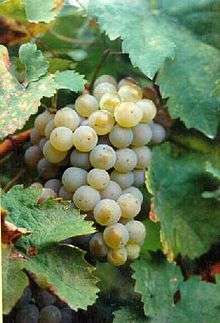Liebfraumilch

Liebfraumilch or Liebfrau(en)milch (German for Beloved lady's milk, in reference to the Virgin Mary) is a style of semi-sweet white German wine which may be produced, mostly for export, in the regions Rheinhessen, Palatinate, Rheingau and Nahe. The original German spelling of the word is Liebfrauenmilch, given to the wine produced from the vineyards of the Liebfrauenkirche or "Church of Our Lady" in the Rhineland-Palatinate city of Worms[1] since the eighteenth century. The spelling Liebfraumilch is more common on labels of exported wine.[2]
The generic label Liebfraumilch is typically used to market vintages from anywhere in the most of the major wine growing areas of Germany, the notable exception being the Mosel. Wine with very similar characteristics but made from higher quality grapes can be labeled as Spätlese or Auslese. In the U.S. and the UK, perhaps the best known example has been Blue Nun, which no longer uses the Liebfraumilch designation.
While the term Liebfraumilch is associated with low quality wine, German wine classification requires it to be at the Qualitätswein bestimmter Anbaugebiete (QbA) level—the second rank of four. It must also be from Rheinhessen, Pfalz, Nahe or Rheingau, the grapes used must be at least 70% Riesling, Silvaner or Müller-Thurgau, and it must have 18–40 grams per litre (2.9–6.4 oz/imp gal) residual sugar.
See also
References
- ↑ Eric Pfanner (October 12, 2012). "After the Debacle Called Liebfraumilch". Retrieved August 21, 2016.
- ↑ Wein-Plus Glossar: Liebfrauenmilch, read on January 24, 2013 (subscription required)